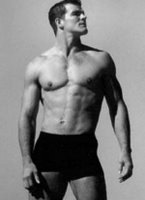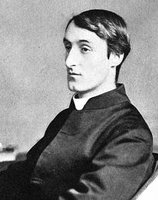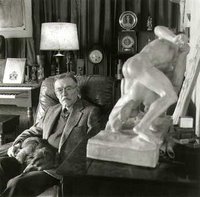 Lionel Bart born 1 August 1930 (d. 1999)
Lionel Bart born 1 August 1930 (d. 1999)Lionel Bart was an English composer of songs and musicals, best known for Oliver!
Bart was born Lionel Begleiter the youngest of seven surviving children in East London to Galician Jews, and grew up in Stepney. His father worked as a tailor in a garden shed in London E1. The family had escaped the pogroms in Galicia, which was then part of the Austrian Empire.
Lionel later changed his name to Bart derived from the name of the silk screen printing firm he and one John Gorman created (G & B Arts, for Gorman and Begleiter) after completing his National Service.
As a young man he was quite an accomplished painter. When Lionel Bart was six years old a teacher told his parents that he was a musical genius. His parents gave him an old violin, but he did not apply himself and the lessons stopped.
At the age of 16 he obtained a scholarship to St Martin's School of Art but he was expelled for 'mischievousness', and he gave up his ambition to be a painter. However, he took jobs in silk-screen printing works and commercial art studios. He never learned to read or write musical notation; this did not stop him from becoming a highly significant personality in the development of British rock and pop music.
He started his songwriting career in amateur theatre at The International Youth Centre in 1952 and at London's Unity Theatre the following year. While at Unity he was talent spotted by Joan Littlewood and so joined Theatre Workshop.
He first gained widespread recognition through his songwriting, which includes the hits Livin' Doll (written for Cliff Richard) and several hits including Little White Bull (for Tommy Steele). In 1957, he won three Ivor Novello awards, a further four in 1958, and two in 1960.
He wrote the theme song for the 1963 James Bond movie From Russia With Love.
 His first professional musical was the 1959 Lock Up Your Daughters, based on an 18th century play by Henry Fielding. Following that, Fings Ain't Wot They Used T'Be produced by Joan Littlewood's Theatre Workshop, was notable for encouraging the use of authentic Cockney accents on the London stage.
His first professional musical was the 1959 Lock Up Your Daughters, based on an 18th century play by Henry Fielding. Following that, Fings Ain't Wot They Used T'Be produced by Joan Littlewood's Theatre Workshop, was notable for encouraging the use of authentic Cockney accents on the London stage.Oliver! (1960), based on Dickens' Oliver Twist was a huge hit from the very beginning, and has sustained its popularity to the present day. The musical spawned such song hits as As Long As He Needs Me (a smash for Shirley Bassey) and Consider Yourself. In 1968 it was made into a film which won several Oscars, including best film.
 Bart's next two musicals, Blitz! (1962) and Maggie May (1964), had respectable West End runs but Twang! (1965) was a notorious flop and La Strada (1969), which opened on Broadway in New York City, closed after only one performance. Bart used his personal finances to try to rescue them, selling his rights to others of his works, including Oliver!, in order to generate capital. By 1972, Bart was bankrupt. He turned to drink, and a twenty-year period of depression ensued, from which he ultimately recovered, attending Alcoholics Anonymous.
Bart's next two musicals, Blitz! (1962) and Maggie May (1964), had respectable West End runs but Twang! (1965) was a notorious flop and La Strada (1969), which opened on Broadway in New York City, closed after only one performance. Bart used his personal finances to try to rescue them, selling his rights to others of his works, including Oliver!, in order to generate capital. By 1972, Bart was bankrupt. He turned to drink, and a twenty-year period of depression ensued, from which he ultimately recovered, attending Alcoholics Anonymous.He continued writing songs and themes for films, but his only real success in his later years was Happy Endings, a 1989 advertising jingle for Abbey National.
 In 1986 Bart received a special Ivor Novello Award for his life's achievement. Cameron Mackintosh, who owned half the rights to Oliver!, revived the musical at the London Paladium in 1994 in a version rewritten by Lionel Bart. Cameron Mackintosh gave Lionel a share of the production royalties.
In 1986 Bart received a special Ivor Novello Award for his life's achievement. Cameron Mackintosh, who owned half the rights to Oliver!, revived the musical at the London Paladium in 1994 in a version rewritten by Lionel Bart. Cameron Mackintosh gave Lionel a share of the production royalties.Although Lionel Bart was known to be gay by those in the theatre world he was often publicly romantically linked with Judy Garland or Alma Cogan - a dead giveaway to a practiced eye.
Bart died in 1999 after a long hard struggle with cancer.
A musical play based on Bart's life and using his songs, It's a Fine Life was staged at the Queen's Theatre, Hornchurch in 2006.
I'd Do Anything, a TV talent show to cast the roles of Oliver and Nancy for a new Cameron Mackintosh West End production of Oliver! was a huge ratings hit for the BBC in 2008 and the ensuing production enjoyed a successful two-year run in the West End.
.bmp)











































.jpg)